Carnatic wars
| Carnatic wars | ||||||||
|---|---|---|---|---|---|---|---|---|
| Part of theDecline of the Mughal Empire,Anglo-French warsand theAnglo-Indian wars | ||||||||
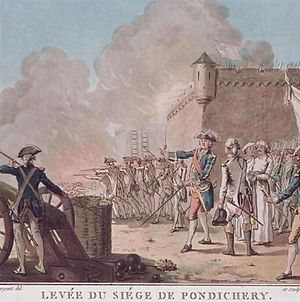 End of the siege of Pondicherry in 1748. | ||||||||
| ||||||||
| Belligerents | ||||||||
| Commanders and leaders | ||||||||
TheCarnatic warswere a series of military conflicts in the middle of the 18th century in India's coastalCarnatic region,a dependency ofHyderabad State,India. The first Carnatic wars were fought between 1740 and 1748.
The conflicts involved numerous nominally independent rulers and their vassals, struggles for succession and territory, and furthermore included a diplomatic and military struggle between theFrench East India Companyand the BritishEast India Company.They were mainly fought within the territories ofMughal Indiawith the assistance of various fragmented polities loyal to the "Great Moghul".
As a result of these military contests, the British East India Company established its dominance among the European trading companies within India. The French company was pushed to a corner and was confined primarily toPondicherry.The East India Company's dominance eventually led to control by the British Company over most of India and eventually to the establishment of theBritish Raj.
Background
[edit]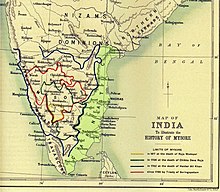
TheMughalEmperorAurangzebdied in 1707. He was succeeded byBahadur Shah I,but there was a general decline in central control over the empire during the tenure ofJahandar Shahand later emperors.Nizam-ul-Mulkestablished Hyderabad as an independent kingdom. A power struggle ensued after his death between his son,Nasir Jung,and his grandson,Muzaffar Jung,which soon involved foreign powers eager to expand their influence. France aided Muzaffar Jung while Britain aided Nasir Jung. Several erstwhile Mughal territories were autonomous such as the Carnatic, ruled by NawabDost Ali Khan,despite being under the legal purview of theNizam of Hyderabad.French and British support soon became intertwined with the affairs of the Nawab. Dost Ali's death sparked a power struggle between his son-in-lawChanda Sahib,supported by the French, andMuhammad Ali,supported by the British.[2]
One major instigator of the Carnatic wars was the FrenchmanJoseph François Dupleix,who arrived in India in 1715, rising to become the French East India Company's governor in 1742. Dupleix sought to expand French influence in India, which was limited to a few trading outposts, the chief one beingPondicherryon theCoromandel Coast.Immediately upon his arrival in India, he organized Indian recruits under French officers for the first time, and engaged in intrigues with local rulers to expand French influence. However, he was met by the equally challenging and determined young officer from the British Army,Robert Clive.
"The Austrian War of Succession in 1740 and later the war in 1756 automatically led to a conflict in India...and British reverses during the American War of Independence (1775–1783) in the 1770s had an impact on events in India."[2]
First Carnatic War (1746–1748)
[edit]
In 1740, theWar of the Austrian Successionbroke out in Europe. Great Britain was drawn into the war in 1744, opposed toFranceand its allies. The trading companies of both countries maintained cordial relations in India while their parent countries were bitter enemies on the European continent. Dodwell writes, "Such were the friendly relations between the English and the French that the French sent their goods and merchandise fromPondicherrytoMadrasfor safe custody. "[3]Although French company officials were ordered to avoid conflict, British officials were not, and were furthermore notified that aRoyal Navyfleet was en route. After the British initially captured a few French merchant ships, the French called for backup from as far afield asIsle de France(nowMauritius), beginning an escalation in naval forces in the area. In July 1746, French commanderLa Bourdonnaisand British AdmiralEdward Peytonfoughtan indecisive actionoff Negapatam, after which the British fleet withdrew to Bengal. On 21 September 1746, the Frenchcaptured the British outpost at Madras.La Bourdonnais had promised to return Madras to the British, butJoseph François Dupleixwithdrew that promise, and wanted to give Madras to Anwar-ud-din after the capture. The Nawab then sent a 10,000-man army to take Madras from the French but was decisively repulsed by a small French force in theBattle of Adyar.The French then made several attempts to capture the BritishFort St. DavidatCuddalore,but the timely arrivals of reinforcements halted these and eventually turned the tables on the French. British AdmiralEdward Boscawenbesieged Pondicherryin the later months of 1748, but lifted the siege with the advent of themonsoonrains in October.[2]
With the termination of theWar of the Austrian Successionin Europe, theFirst Carnatic Waralso came to an end. In theTreaty of Aix-la-Chapelle (1748),Madras was given back to the British in exchange for the Frenchfortress of Louisbourgin North America, which the Britishhad captured.The war was principally notable in India as the first military experience ofRobert Clive,who was taken prisoner at Madras but managed to escape, and who then participated in the defence of Cuddalore and the siege ofPondicherry.The French retained their position as the protectors of nizams of Hyderabad.
Second Carnatic War (1749–1754)
[edit]Though a state of war did not exist in Europe, theproxy warcontinued in India. On one side wasNasir Jung,the Nizam and his protege Muhammad Ali, supported by the British, and on the other wasChanda SahibandMuzaffar Jung,supported by the French, vying to become the Nawab ofArcot.Muzaffar Jung and Chanda Sahib were able to capture Arcot while Nasir Jung's subsequent death allowed Muzaffar Jung to take control ofHyderabad.Muzaffar's reign was short as he was soon killed, andSalabat Jungbecame Nizam. In 1751, however, Robert Clive led British troops to captureArcot,and successfullydefend it.The war ended with theTreaty of Pondicherry,signed in 1754, which recognisedMuhammad Ali Khan Walajahas theNawab of the Carnatic.Charles Godeheureplaced Dupleix, who died in poverty back in France.[2]
Third Carnatic War (1757–1763)
[edit]The outbreak of theSeven Years' Warin Europe in 1756 resulted in renewed conflict between French and British forces in India. In this time the French were facing many financial problems. TheThird Carnatic Warspread beyond southern India and intoBengalwhere British forces captured the French settlement ofChandernagorein 1757. However, the war was decided in the south, where the Britishsuccessfully defended Madras,andSir Eyre Cootedecisively defeated the French, commanded by theComte de Lallyat theBattle of Wandiwashin 1760. After Wandiwash, Pondicherryfell to the British in 1761.[2]
Aftermath
[edit]The war concluded with the signing of theTreaty of Parisin 1763, which returned Chandernagore andPondicherryto France, and allowed the French to have trading posts in India, but forbade French traders from administering them.[citation needed]The French agreed to support British client governments, thus ending French ambitions of an Indian empire and making the British the dominant foreign power in India.
Gallery
[edit]-
The British surrender of Madras, 1746.
-
TheSiege of Arcot(1751) was a major battle fought betweenRobert Cliveand the combined forces of theMughal Empire'sNawab of the Carnatic,Chanda Sahib,assisted by a small number of troops from theFrench East India Company
-
Robert Clivefires a cannon in theSiege of Arcot.
-
French and English boats position nearPondicherry.French National Archives.
-
Death of theNawabAnwaruddin Mohammed Khanin a battle (battle of Ambur) against the French in 1749 (byPaul Philippoteaux).
-
Lally atPondicherry.
-
TheBlack Hole of Calcutta,20 June 1756.
-
Jean Law's Memoire:Mémoires sur quelques affaires de l'Empire Mogol 1756–1761contains detailed information about the campaign of theMughal EmperorShah Alam IIand hisFrenchallies against the BritishEast India Company.[4]
-
English guns at the battle ofPlassey,23 June 1757.
-
Mughalartillerymen at Plassey during the Carnatic wars.
See also
[edit]References
[edit]- ^Benians, Ernest Alfred; Newton, Arthur Percival; Rose, John Holland (1929).The Cambridge History of the British Empire.p. 126.Retrieved16 December2014.
- ^abcdeNaravane, M.S. (2014).Battles of the Honorourable East India Company.A.P.H. Publishing Corporation. pp. 150–159.ISBN9788131300343.
- ^Dodwell, H. H. (ed), Cambridge History of India, Vol. v.
- ^"Niall Ferguson – Empire: How Britain Made the Modern World – Why Britain? 4/5".Archived fromthe originalon 31 March 2021.Retrieved28 September2014– via YouTube.
- ^Palk Manuscripts,four-volume collection of the correspondence of Sir Robert Palk relating to Indian affairs,Historical Manuscripts Commission: Report on the Palk manuscripts in the possession of Mrs Bannatyne of Haldon, Devon,p.XII[1]
- Carnatic wars
- 1740s conflicts
- 1750s conflicts
- Wars involving India
- Wars involving France
- Wars involving Great Britain
- Colonial India
- 18th century in India
- History of Tamil Nadu
- Military history of India
- 1746 in India
- 1749 in India
- 1757 in India
- Seven Years' War
- History of Tiruchirappalli
- Wars of succession involving the states and peoples of Europe
- Wars of succession involving the states and peoples of Asia


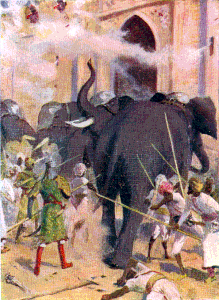
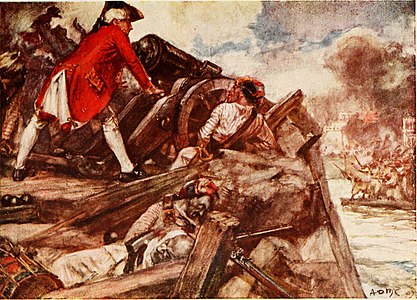

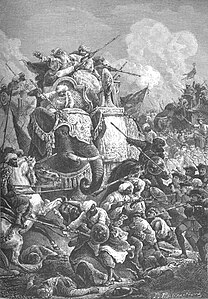

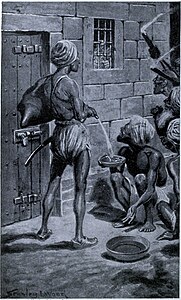
![Jean Law's Memoire: Mémoires sur quelques affaires de l'Empire Mogol 1756–1761 contains detailed information about the campaign of the Mughal Emperor Shah Alam II and his French allies against the British East India Company.[4]](https://upload.wikimedia.org/wikipedia/commons/thumb/3/34/Shah-alam-ii-mughal-emperor-of-india-reviewing-the-east-india-companys-troops-1781-1894_1247854.jpg/395px-Shah-alam-ii-mughal-emperor-of-india-reviewing-the-east-india-companys-troops-1781-1894_1247854.jpg)



![Stringer Lawrence and Nawab Wallajah in Madras[5]](https://upload.wikimedia.org/wikipedia/commons/thumb/d/d7/Stinger_Lawrence_and_Nawab_Wallajah.JPG/204px-Stinger_Lawrence_and_Nawab_Wallajah.JPG)